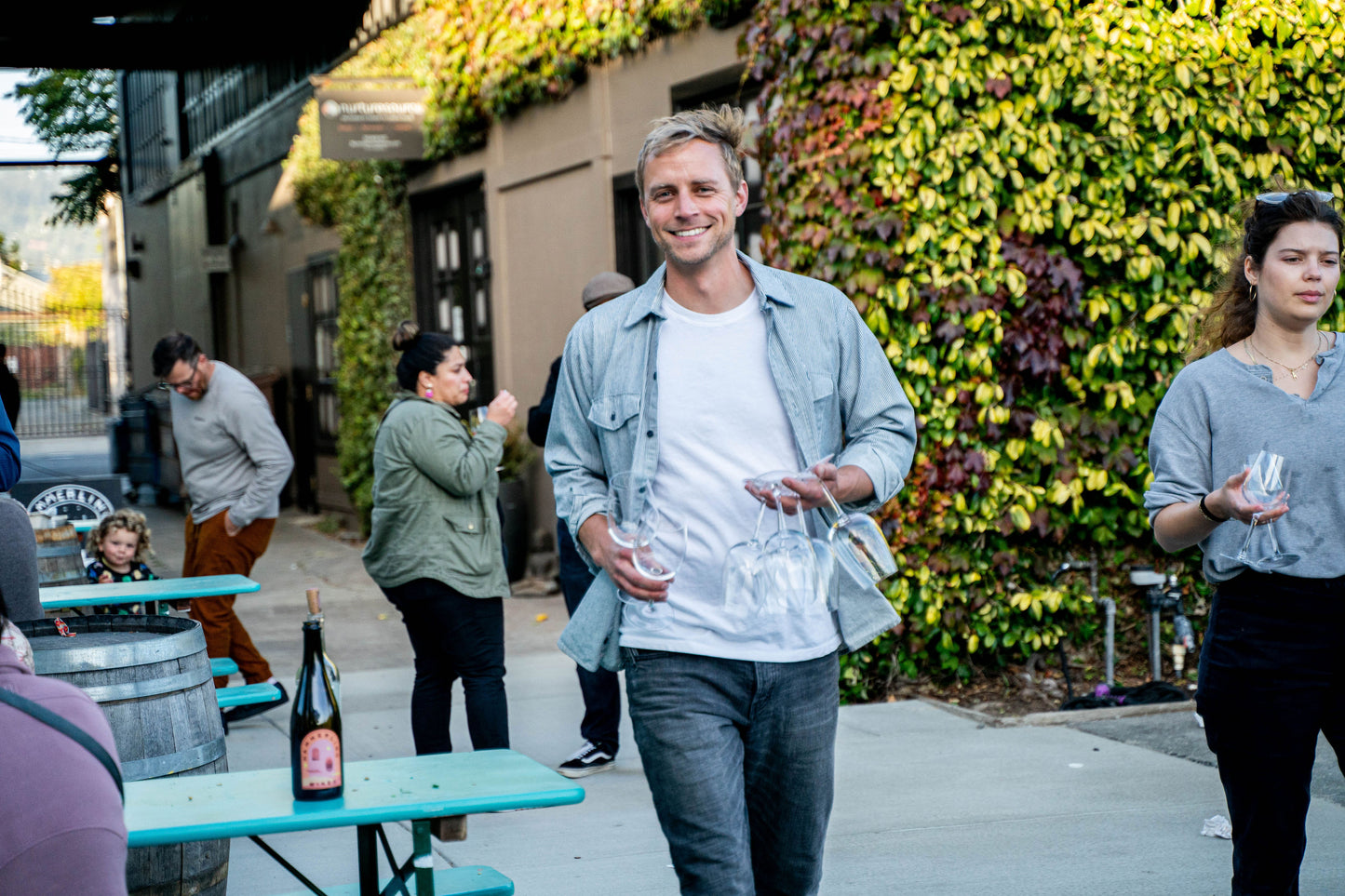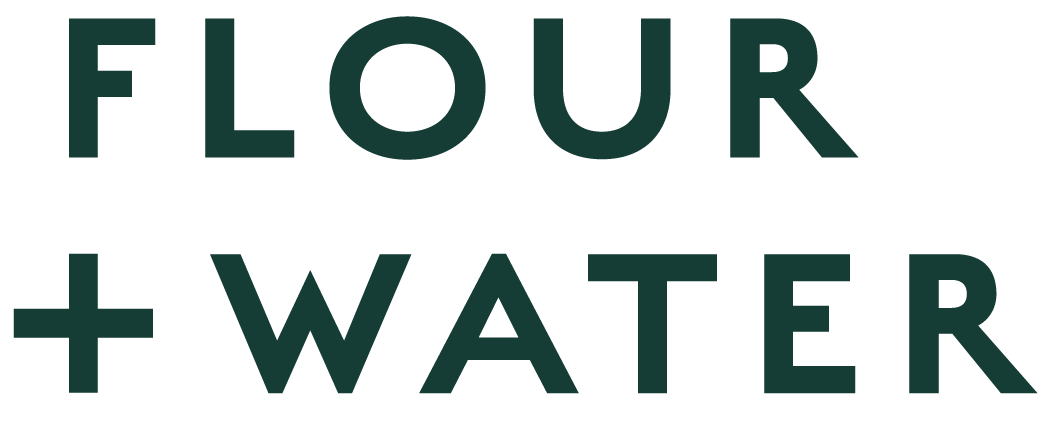
While sparkling wine is always in season at Flour + Water, December is our favorite time of year to pop open (or, very carefully, saber) some bottles.
Today, we're pouring one out with our good friend Josh Hammerling, the founder + winemaker behind Hammerling Wines in Berkeley. Josh founded Hammerling in 2018 with the goal of advancing and contributing to California's growing movement of low-intervention sparkling wines that are evolving perceptions of the style within the region.
In a short time, Josh has become a leading voice in the community, producing innovative wines with a clear sense of place through his exploration of cool-climate California vineyards along the coast. His thoughtful approach is why we were so stoked to team up with him for a collaboration "Big Night" Lambrusco-style bottle that's available at all our Flour + Water Hospitality Group restaurants in San Francisco — and it's also why we're firing these seven questions at him today.
Let's start with the basics. For the uninitiated, how would you describe low-intervention sparkling wines?
Low-intervention winemaking means that we source organically farmed grapes, rely on native yeasts for our primary fermentations as often as possible, and limit SO2 or other additives in the cellar. I’m not dogmatic, so there are exceptions if we need to prevent a wine from spoiling. Our aim is to make the vineyards we work with shine in the best possible light. Sometimes we make pet-nats, but most often they’re traditional method (same way they do it in Champagne). We barrel age our wines for a few months before re-fermenting them in, unfiltered, in the bottle, which creates a more textured flavor profile.
The conversation of low-intervention winemaking has always been complicated for traditional method sparkling wine because it’s by definition high-intervention for the second half of the process. We add yeast at this step, but we’re nurturing something that’s still alive and managing the momentum of the wine as it evolves. It’s an incredibly humbling process, and it takes years to understand how to adjust our approach to different vineyards in the cellar. Each vintage presents new variables to address.

What attracted you to sparkling wine in particular?
There are so many little moments when you get to intervene and change the trajectory of a wine. It’s like cooking over a 3-5 year timeline where you keep adding pinches of salt, reducing the stock, and adding new elements to achieve balance. Beyond that it’s hard to overstate how strange it is to ferment a wine twice. Most people don’t understand how challenging and rewarding that process is when it works. At the end of the day bubbles also pair with pretty much any food, which is a plus.
Looking to the future (even beyond 2025), what excites you about the direction viticulture and winemaking in California is headed?
If you’d asked me this question five or six years ago I’d have answered that we were entering the “anything goes” era. Then we had COVID, wild inflation, and a bit of a crisis moment for the industry that has caused everyone to focus more on the bottom line. I think that spirit of experimentation is still alive—and we need to nurture it—but it’s not just about novelty. People are experimenting with fruit co-ferments, hybrid varieties, N/A offerings, which I love to see. It’s particularly exciting to see a project that goes beyond grapes and embraces biodiversity and regenerative farming. I’m looking forward to seeing where that leads us.
Coming up in the industry, I was taught only chard and pinot were destined for bubbles, so I’m very intrigued by what comes next with hybrids (which entails crossing two different grape species to create something entirely new). While we’ve made sparkling wines from at least 10 different vinifera varieties since we launched Hammerling seven years ago, the stars haven’t aligned for us to work with hybrids yet. There’s no denying the benefits for the environment including disease resistance, and fewer sprays in the vineyard, so it’s an area I want to explore in the future. In general, I would love to see more people applying serious champagne-method techniques to new varieties.
From a winemaking standpoint, I’m also excited to see how we can continue to refine our low-intervention style. There’s so much potential, and I hope the industry continues to hold space for people to experiment.

Walk us through your “Shift Notes.” What’s a day-in-the-life like for you?
The wine industry is intensely seasonal. During harvest I wake up way too early most days to drive grapes back from vineyards around the Central Coast, Napa, El Dorado, and Mendocino. Then we process the fruit, put out any fires that started in the last 24 hours, clean everything and get ready to do it again the next day. For the first five years of this business, harvest weeks often exceeded 120 hours. I’ve tried to rein that in because it’s just not sustainable.
This time of year I still wake up early, but try to do something active, drink coffee, and hang out with my partner and dogs listening to some ambient music. It keeps the dogs really relaxed while I transition into the day. I never take those moments for granted anymore. That’s followed by an hour or two of admin work and trucking cases of wine to our storage facility. After that, I usually start preparing for tirage bottling, riddling, disgorging, or labeling. Every bottle is touched four times in our process, so there’s always something to take care of. We also run a lot of private events, so on down days we’re typically corresponding or staging for parties.
You're known for naming your wines after poems, films, and songs, what album is playing while you’re working?
The film influence came from working with my brother, Jeremiah, and scheming on old arthouse films that could work for wine names. I also have a standing spa date with my sister-in-law, Linnea, when we brainstorm names for upcoming wines. It’s one of my favorite days of the month. We’ve built up a ridiculous list of names, many of which will probably never get used.
When it comes to music, there’s an insane range in the cellar. If we need a boost early these days we’ll dive right into Valentino Vivace, New Order, Channel Tres, the Bobo Yeye collection, Dolly Parton, Stereolab, or maybe Bob James. We’ve also found that darker industrial music like Boy Harsher’s “Careful” is a surprisingly good soundtrack for disgorging. You kind of turn into a machine.
By the middle of the day we’re human again and tend to settle into something that has the feeling of Little Beaver’s “Get into the Party Life.” Not clear if things are ramping up or winding down, but it keeps you going and makes you feel like the barbecue afterparty is about to kick in. If we’re in a sad-boy mood we’ll transition into something like Black Marble.
When we finish up we put on cleaning music. This is really personal and depends on the group. But generally any song from Beyonce’s “Renaissance” or Chaka Khan’s song “Like Sugar” is the direction we’re going for.
What’s your go-to pasta recipe + what are you pouring to go with it?
I’m all about the F+W Campanelle. I always have a few boxes in my pantry. Typically, I just sauté shallots, garlic, anchovies, whatever fresh, canned or sun-dried tomatoes or mushrooms I have on hand, and other salty, citrusy, spicy bits—olives, capers, peppers, whatever herbs are growing in the backyard. And then stir in as much burrata and parmesan as the bowl will hold. I love that meal with cab franc from the Loire or good gamay from anywhere. Obviously, I also love a glass of Big Night in this situation.
Bonus Question: Between coupes, flutes, or regular wine glasses, what's best for enjoying sparkling wine?
I’m all about the white wine glass. You get more aromatics. If you’ve got buds visiting for dinner it’s easy to just give everyone those glasses and transition into red wine whenever you feel like it without using extra glassware.
If you’re visiting friends or out dining in the world and someone gives you a flute, you lose a lot of the aromatics, but you get to watch all the fun bubble trains. No reason to hate. If someone gives you a coupe, do your best Jay Gatsby impression.
